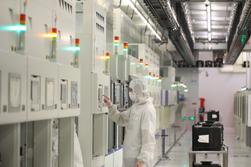 An employee of Semiconductor Manufacturing International Corp works at the company's factory in Beijing. (PHOTO / XINHUA)
An employee of Semiconductor Manufacturing International Corp works at the company's factory in Beijing. (PHOTO / XINHUA)
China will further increase the extra tax deductions on the research and development expenses of manufacturing firms in order to incentivize business innovation and advance industrial upgrading, the State Council executive meeting chaired by Premier Li Keqiang decided on Wednesday.
The principal role of enterprises in making innovations will be better harnessed. More market-oriented, equitable and inclusive support policies will be employed to better motivate the business sector and other private actors to scale up their R&D spending. This will help boost the momentum of economic growth and improve the economic structure.
More market-oriented, equitable and inclusive support policies will be employed to better motivate the business sector and other private actors to scale up their R&D spending
Tax breaks for R&D expenses have been raised in recent years, which has effectively supported corporate innovation.
"This institutional arrangement is the largest in this year's structural tax cuts. Boosting R&D input from society with tax incentives and market-oriented means is an effective way to stimulate technological innovation," Li said.
READ MORE: Tax cuts for small and micro firms extended
To implement the tasks outlined in the Government Work Report in support of business innovation, the ratio of extra tax deductions on enterprises' R&D costs have been raised from 75 percent to 100 percent, starting from Jan 1 this year. This means that for every 1 million yuan (US$150,000) spent on R&D, a company will see 2 million yuan deducted from its taxable income.
This policy is expected to reduce corporate taxes by another 80 billion yuan this year, on top of the 360 billion yuan tax cuts last year.
"There is still room to further scale up this policy. Deeper tax cuts can be introduced as things develop," Li said. "We should accumulate experience along the way and simplify the procedures in a step-by-step manner."
ALSO READ: Rolls-Royce eyes more Chinese parts
The calculation method in the tax deduction of R&D costs will be reformed. Enterprises may choose to benefit from the tax incentive on a semiannual basis, allowing R&D spending in the first half of the year to be deducted during the prepayment of corporate income tax in October, rather than during its settlement in the next year. The reform aims to let enterprises benefit as early as possible.
Preferential tax policies will also be considered for R&D service providers, innovative firms and business startups.
Efforts will be made to strengthen policy advocacy, improve tax services and streamline review processes, to make it easier for enterprises to benefit and see that the policies are effectively implemented.
"It is important to further encourage companies to increase R&D spending. Investing more in R&D will help companies bolster their growth potential," Li said.


